Mechanical Characterisation and Shrinkage of Thermoactivated Recycled Cement Concrete
Abstract
1. Introduction
2. Experimental Programme
2.1. Materials
2.2. Composition and Production of Recycled Cement Concrete
2.3. Test Methods
3. Results and Discussion
3.1. Slump and Density
3.2. Compressive Strength
3.3. Tensile Splitting Strength
3.4. Modulus of Elasticity
3.5. Ultrasonic Pulse Velocity
3.6. Drying Shrinkage
4. Conclusions
Author Contributions
Funding
Institutional Review Board Statement
Informed Consent Statement
Data Availability Statement
Acknowledgments
Conflicts of Interest
References
- Carriço, A.; Bogas, J.; Guedes, M. Thermoactivated cementitious materials—A review. Constr. Build. Mater. 2020, 250, 118873. [Google Scholar] [CrossRef]
- World Business Council for Sustainable Development and International Energy Agency. Cement Technology Roadmap 2009. Carbon Emissions Reductions Up to 2050; World Business Council for Sustainable Development (WBCSD): Geneva, Switzerland; International Energy Agency (IEA): Paris, France, 2009. [Google Scholar]
- Brito, J.; Saikia, N. Recycled Aggregate in Concrete: Use of Industrial, Construction and Demolition Waste; Springer: London, UK, 2013. [Google Scholar]
- Shui, Z.; Xuan, D.; Chen, W.; Yu, R.; Zhang, R. Cementitious characteristics of hydrated cement paste subjected to various dehydration temperatures. Constr. Build. Mater. 2009, 23, 531–537. [Google Scholar] [CrossRef]
- Alonso, C.; Fernandez, L. Dehydration and rehydration processes of cement paste exposed to high temperature environments. J. Mater. Sci. 2004, 39, 3015–3024. [Google Scholar] [CrossRef]
- Vyšvaril, M.; Bayer, P.; Chromá, M.; Rovnaníková, P. Physico-mechanical and microstructural properties of rehydrated blended cement pastes. Constr. Build. Mater. 2014, 54, 413–420. [Google Scholar] [CrossRef]
- Wang, J.; Mu, M.; Liu, Y. Recycled cement. Constr. Build. Mater. 2018, 190, 1124–1132. [Google Scholar] [CrossRef]
- Zhang, L.; Ji, Y.; Huang, G.; Li, J.; Hu, Y. Modification and enhancement of mechanical properties of dehydrated cement paste using ground granulated blast-furnace slag. Constr. Build. Mater. 2018, 164, 525–534. [Google Scholar] [CrossRef]
- Real, S.; Carriço, A.; Bogas, J.; Guedes, M. Influence of the treatment temperature on the microstructure and hydration behavior of thermoactivated recycled cement. Materials 2020, 13, 3937. [Google Scholar] [CrossRef] [PubMed]
- Bogas, J.; Carriço, A.; Tenza-Abril, A. Microstructure of thermoactivated recycled cement pastes. Cem. Concr. Res. 2020, 138, 106226. [Google Scholar] [CrossRef]
- Shui, Z.; Xuan, D.; Wan, H.; Cao, B. Rehydration reactivity of recycled mortar from concrete waste experienced to thermal treatment. Constr. Build. Mater. 2008, 22, 1723–1729. [Google Scholar] [CrossRef]
- Florea, M.; Ning, Z.; Brouwers, H. Activation of liberated concrete fines and their application in mortars. Constr. Build. Mater. 2014, 50, 1–12. [Google Scholar] [CrossRef]
- Serpell, R.; Lopez, M. Properties of mortars produced with reactivated cementitious materials. Cem. Concr. Compos. 2015, 64, 16–26. [Google Scholar] [CrossRef]
- Bogas, J.A.; Carriço, A.; Pereira, M.F.C. Mechanical characterization of thermal activated low-carbon recycled cement mortars. J. Clean. Prod. 2019, 218, 377–389. [Google Scholar] [CrossRef]
- Kalinowska-Wichrowska, K.; Kosior-Kazberuk, M.; Pawluczuk, E. The properties of composites with recycled cement mortar used as a supplementary cementitious material. Materials 2020, 13, 64. [Google Scholar] [CrossRef] [PubMed]
- Carriço, A.; Real, S.; Bogas, J.; Pereira, M. Mortars with thermoactivated recycled cement: Fresh and mechanical characterisation. Constr. Build. Mater. 2020, 256, 119502. [Google Scholar] [CrossRef]
- Sui, Y.; Ou, C.; Liu, S.; Zhang, J.; Tian, Q. Study on properties of waste concrete powder by thermal treatment and application in mortar. Appl. Sci. 2020, 10, 998. [Google Scholar] [CrossRef]
- Zhang, L.; Ji, Y.; Li, J.; Gao, F.; Huang, G. Effect of retarders on the early hydration and mechanical properties of reactivated cementitious material. Constr. Build. Mater. 2019, 212, 192–201. [Google Scholar] [CrossRef]
- Baldusco, R.; Nobre, T.; Angulo, S.; Quarcioni, V.; Cincotto, M. Dehydration and rehydration of blast furnace slag cement. J. Mater. Civ. Eng. 2019, 31, 04019132. [Google Scholar] [CrossRef]
- Yu, R.; Shui, Z. Influence of agglomeration of a recycled cement additive on the hydration and microstructure development of cement based materials. Constr. Build. Mater. 2013, 49, 841–851. [Google Scholar] [CrossRef]
- Letelier, V.; Tarela, E.; Muñoz, P.; Moriconi, G. Combined effects of recycled hydrated cement and recycled aggregates on the mechanical properties of concrete. Constr. Build. Mater. 2017, 132, 365–375. [Google Scholar] [CrossRef]
- Qian, D.; Yu, R.; Shui, Z.; Sun, Y.; Jiang, C. A novel development of green ultra-high performance concrete (UHPC) based on appropriate application of recycled cementitious material. J. Clean. Prod. 2020, 261, 121231. [Google Scholar] [CrossRef]
- EN 1097-6. Tests for mechanical and physical properties of aggregates. In Determination of Particle Density and Water Absorption; European Committee for Standardization (CEN): Brussels, Belgium, 2013. [Google Scholar]
- EN 1097-3. Tests for mechanical and physical properties of aggregates. In Determination of Loose Bulk Density and Voids; European Committee for Standardization (CEN): Brussels, Belgium, 1998. [Google Scholar]
- EN 12620. Aggregates for Concrete; European Committee for Standardization (CEN): Brussels, Belgium, 2013. [Google Scholar]
- EN 196-2. Method of testing cement. In Chemical Analysis of Cement; European Committee for Standardization (CEN): Brussels, Belgium, 2013. [Google Scholar]
- EN 451-1. Method of testing fly ash. In Determination of Free Calcium Oxide Content; European Committee for Standardization (CEN): Brussels, Belgium, 2017. [Google Scholar]
- EN 196-3. Methods of Testing Cement—Part 3: Determination of Setting Times and Soundness; European Committee for Standardization (CEN): Brussels, Belgium, 2016. [Google Scholar]
- LNEC E 64. Cement. Determination of Density; Laboratorio Nacional de Engenharia Civil (LNEC): Lisbon, Portugal, 1979. (In Portuguese) [Google Scholar]
- Bogas, J.; Pereira, M.; Guedes, A.; Carriço, A.; Hu, S.; Sousa, R. Separation Process of Waste Hardened Concrete for Obtaining Recycled Cement from Waste Concrete . Application No. 116130, 2020. [Google Scholar]
- EN 206. Concrete. Specification, Performance, Production and Conformity; European Committee for Standardization (CEN): Brussels, Belgium, 2013. [Google Scholar]
- EN 12350-2. Testing Fresh Concrete. Slump Test; European Committee for Standardization (CEN): Brussels, Belgium, 2019. [Google Scholar]
- EN 12350-6. Testing Fresh Concrete. Density; European Committee for Standardization (CEN): Brussels, Belgium, 2019. [Google Scholar]
- EN 12390-7. Testing Hadened Concrete—Part 7: Density of Hardened Concrete; European Committee for Standardization (CEN): Brussels, Belgium, 2009. [Google Scholar]
- EN 12390-3. Testing Hardened Concrete. Compressive Strength of Test Specimens; European Committee for Standardization (CEN): Brussels, Belgium, 2019. [Google Scholar]
- EN 12504-4. Testing Concrete—Part 4: Determination of Ultrasonic Pulse Velocity; European Committee for Standardization (CEN): Brussels, Belgium, 2004. [Google Scholar]
- EN 12390-6. Testing Hardened Concrete—Part 6: Tensile Splitting Strength of Test Specimens; European Committee for Standardization (CEN): Brussels, Belgium, 2009. [Google Scholar]
- LNEC E 397. Concrete. Determination of Modulus of Elasticity; Laboratorio Nacional de Engenharia Civil (LNEC): Lisbon, Portugal, 1993. (In Portuguese) [Google Scholar]
- LNEC E 398. Concrete. Determination of Shrinkage and Expansion; Laboratorio Nacional de Engenharia Civil (LNEC): Lisbon, Portugal, 1993. (In Portuguese) [Google Scholar]
- Ma, X.; Han, Z.; Li, X. Reactivity of dehydrated cement paste from waste concrete subjected to heat treatment. In Proceedings of the Second International Conference on Sustainable Construction Materials and Technologies, Università Politecnica delle Marche, Ancona, Italy, 28–30 June 2010. [Google Scholar]
- Angulo, S.; Guilge, M.; Quarcioni, V.; Baldusco, R.; Cincotto, M. Rehydration of Cement Fines: A TG/Calorimetry Study; Institute for Technological Research: São Paulo, Brazil, 2013. [Google Scholar]
- EN 1992-1-1. Eurocode 2: Design of Concrete Concrete Structures—Part 1-1: General Rules and Rules for Buildings; European Committee for Standardization (CEN): Brussels, Belgium, 2004. [Google Scholar]
- ACI 318. Building Code Requirements for Structural Concrete (ACI 318-14) and Commentary; American Concrete Institute (ACI): Farmington Hills, MI, USA, 2014. [Google Scholar]
- Bogas, J.; Nogueira, R. Tensile strength of structural expanded clay lightweight concrete subjected to different curing conditions. KSCE J. Civ. Eng. 2014, 18, 1789–1791. [Google Scholar] [CrossRef]
- Bogas, J.; Gomes, M.; Gomes, A. Compressive strength evaluation of structural lightweight concrete by non-destructive ultrasonic pulse velocity method. Ultrasonics 2013, 53, 962–972. [Google Scholar] [CrossRef] [PubMed]
- Bogas, J.; Nogueira, R.; Almeida, N. Influence of mineral additions and different compositional parameters on the shrinkage of structural expanded clay lightweight concrete. Mater. Des. 2014, 56, 1039–1048. [Google Scholar] [CrossRef]

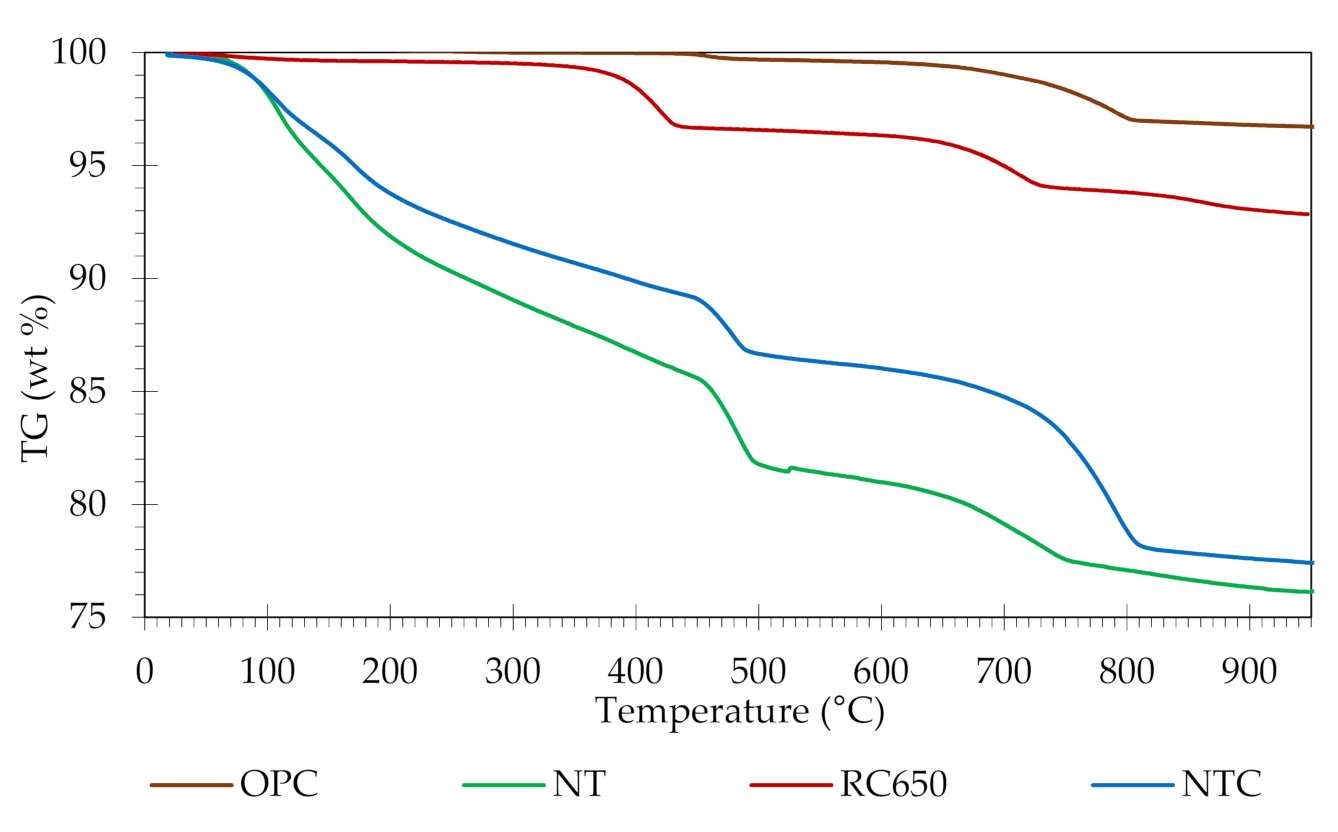
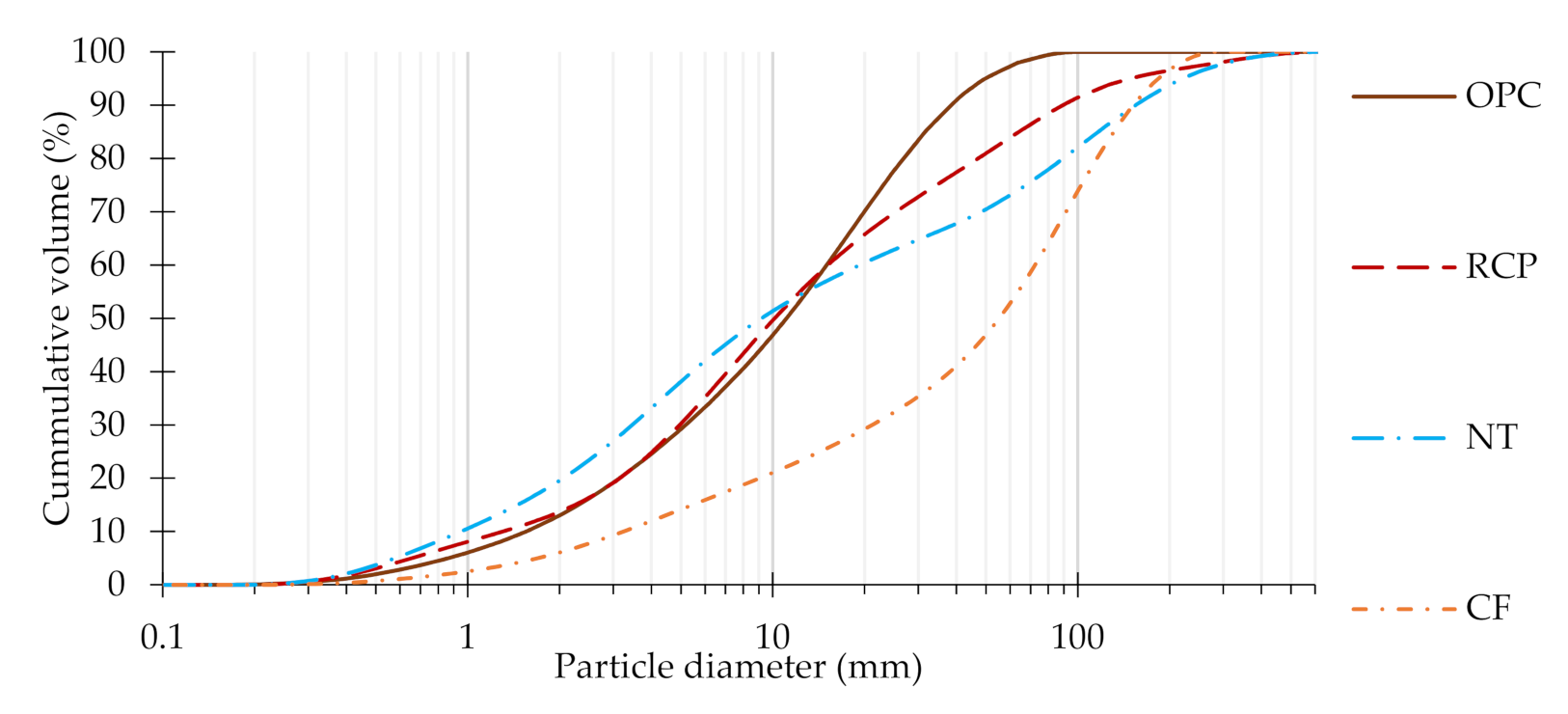

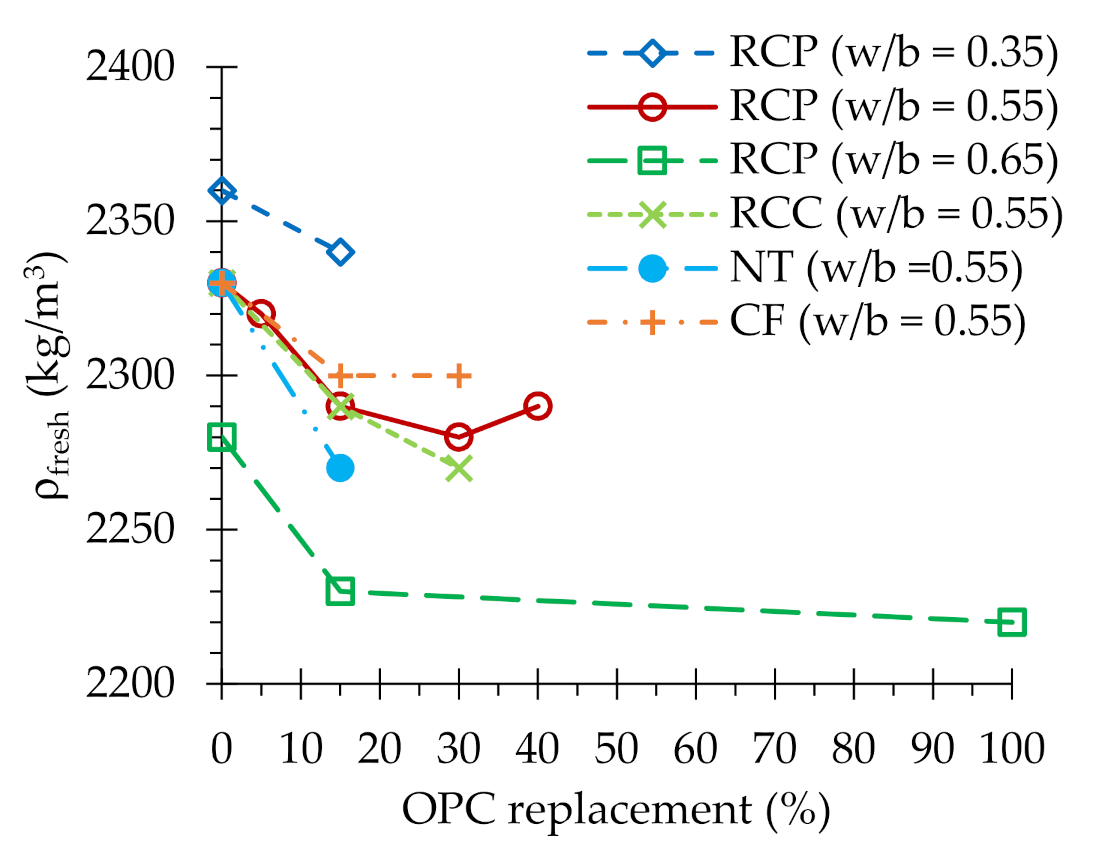
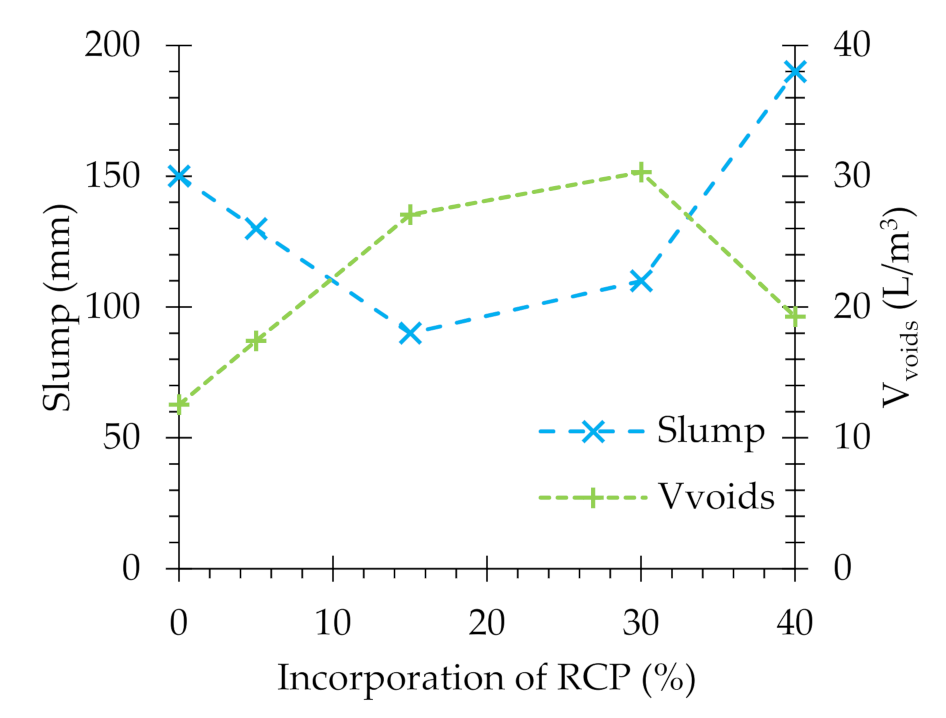
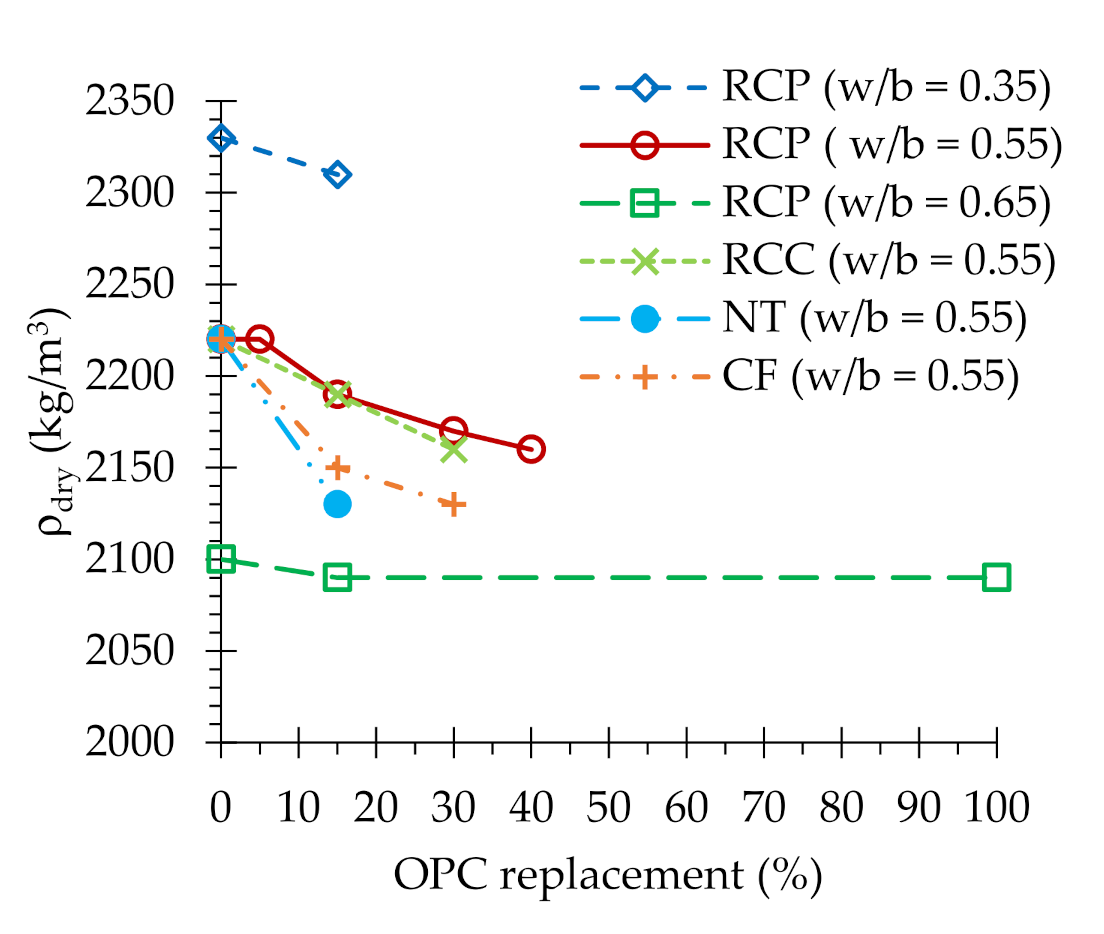
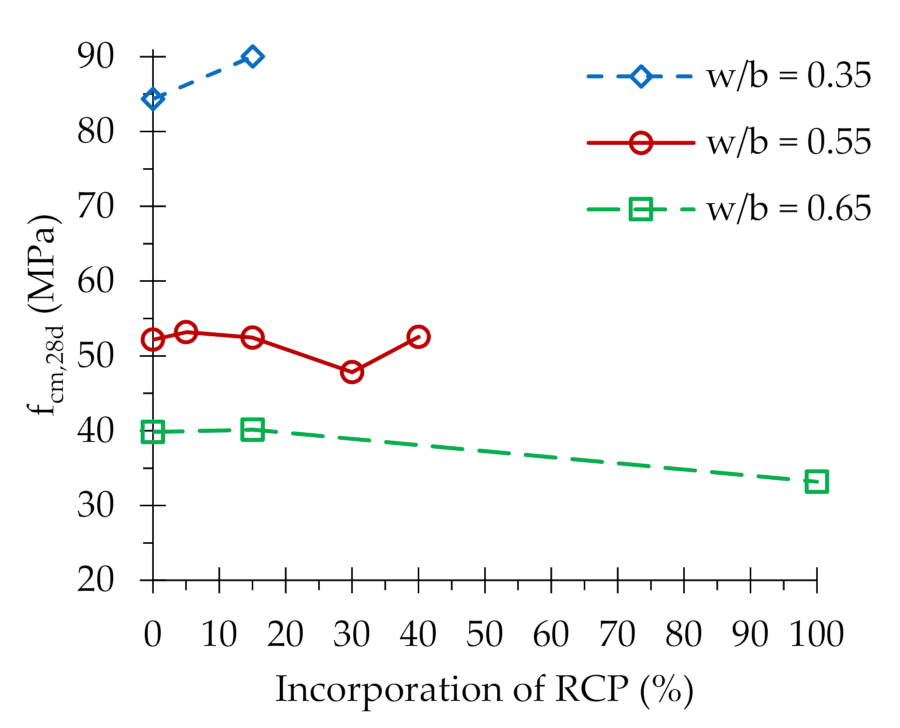
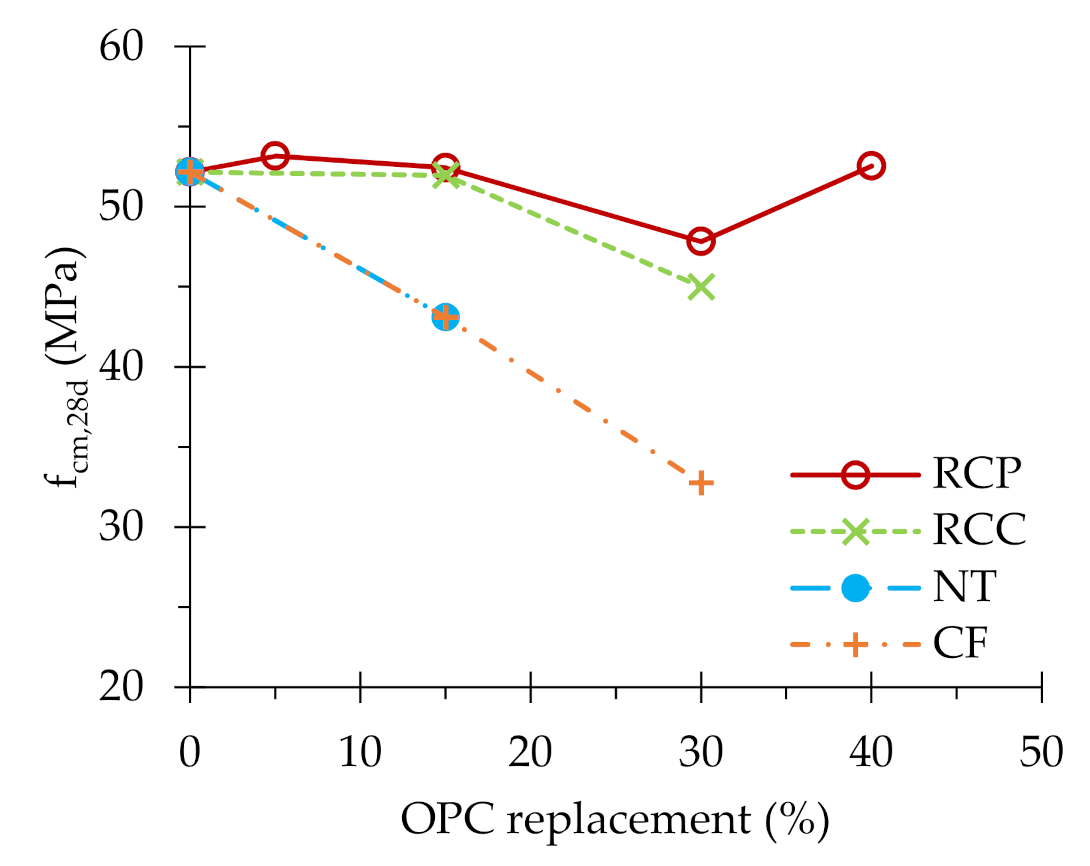
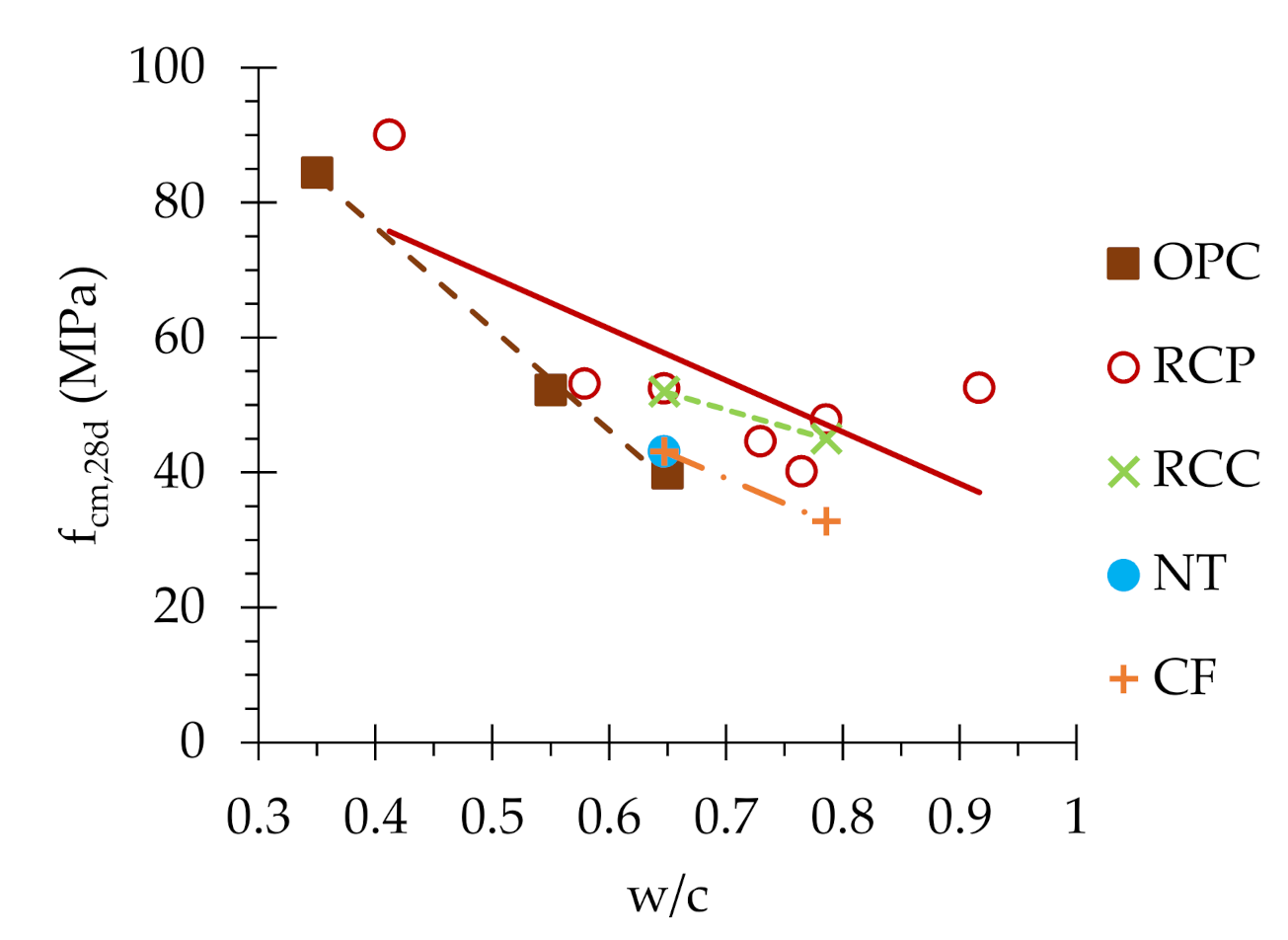
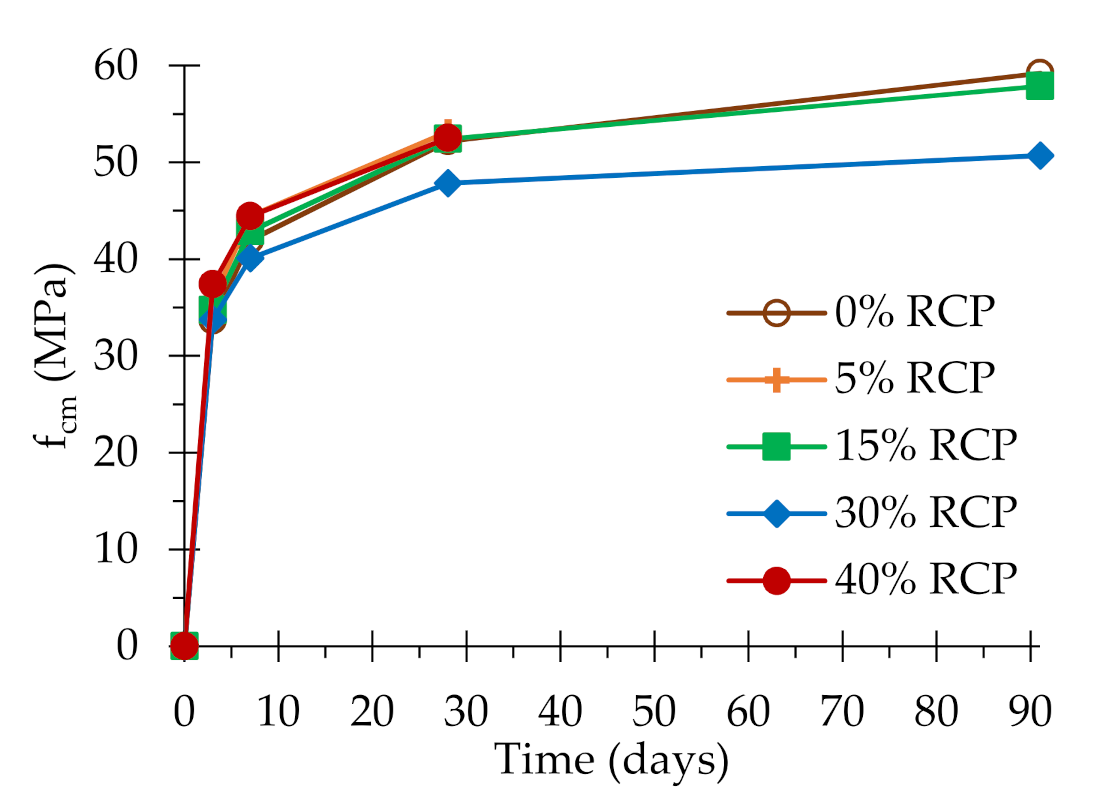
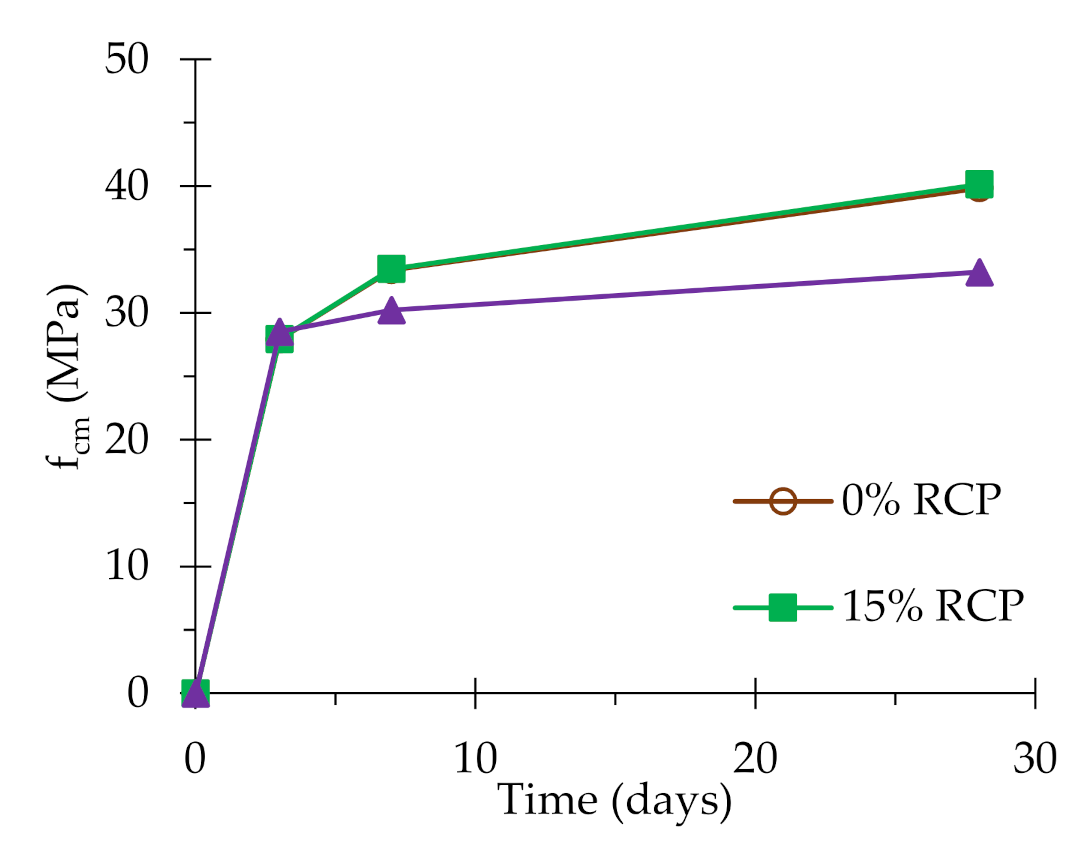

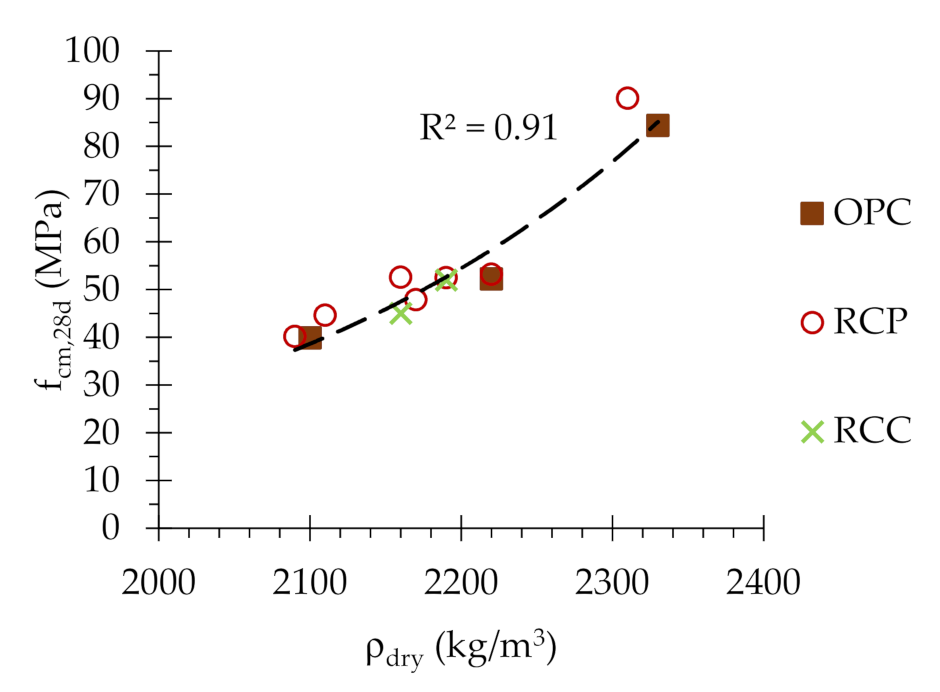



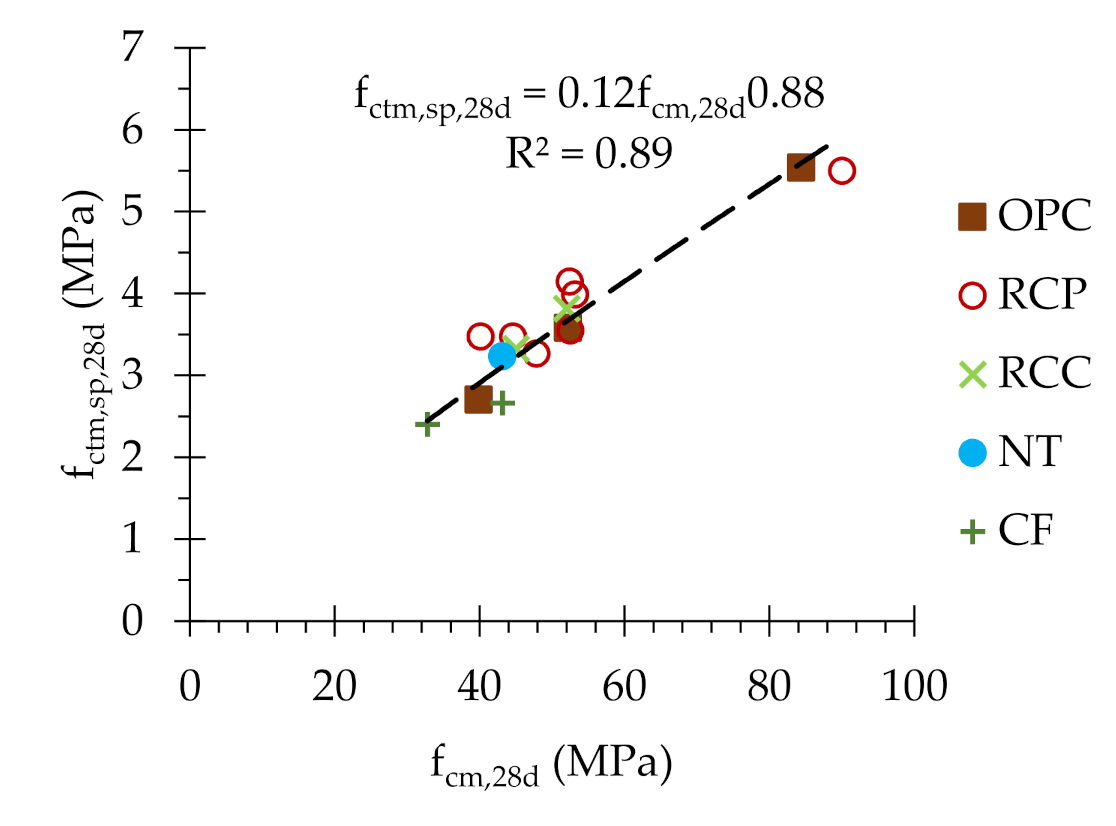
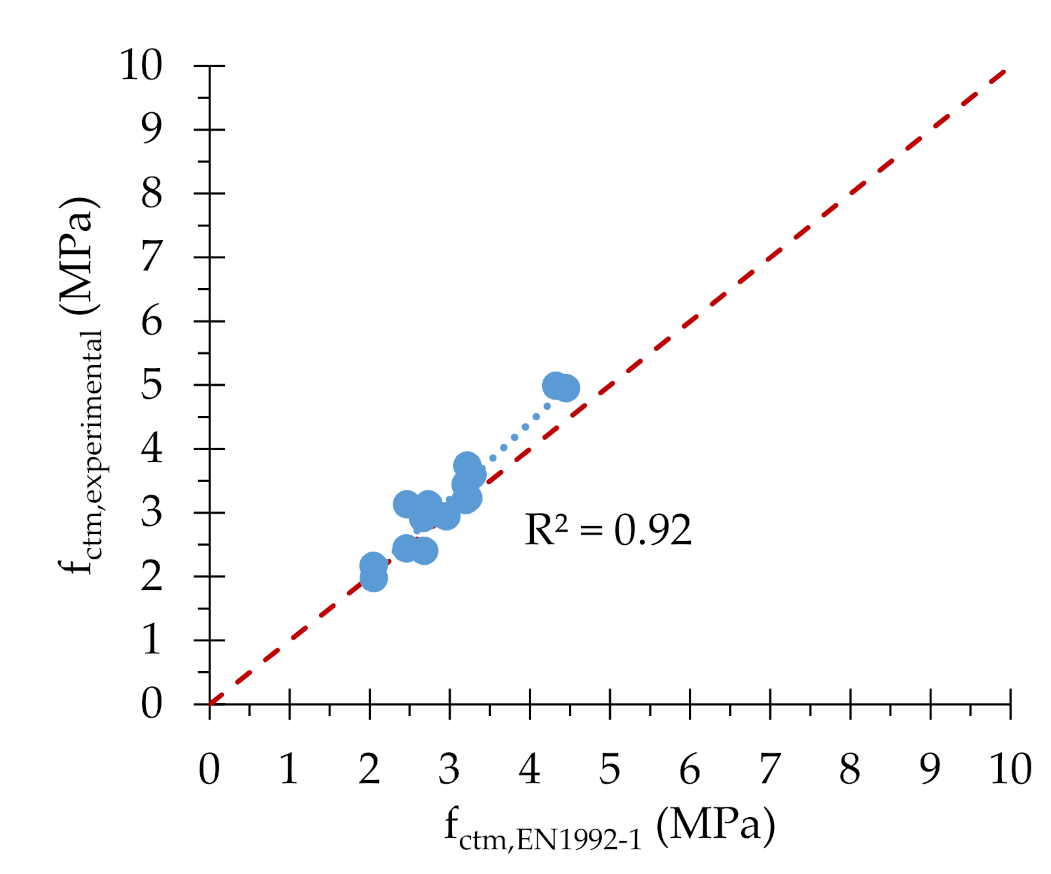

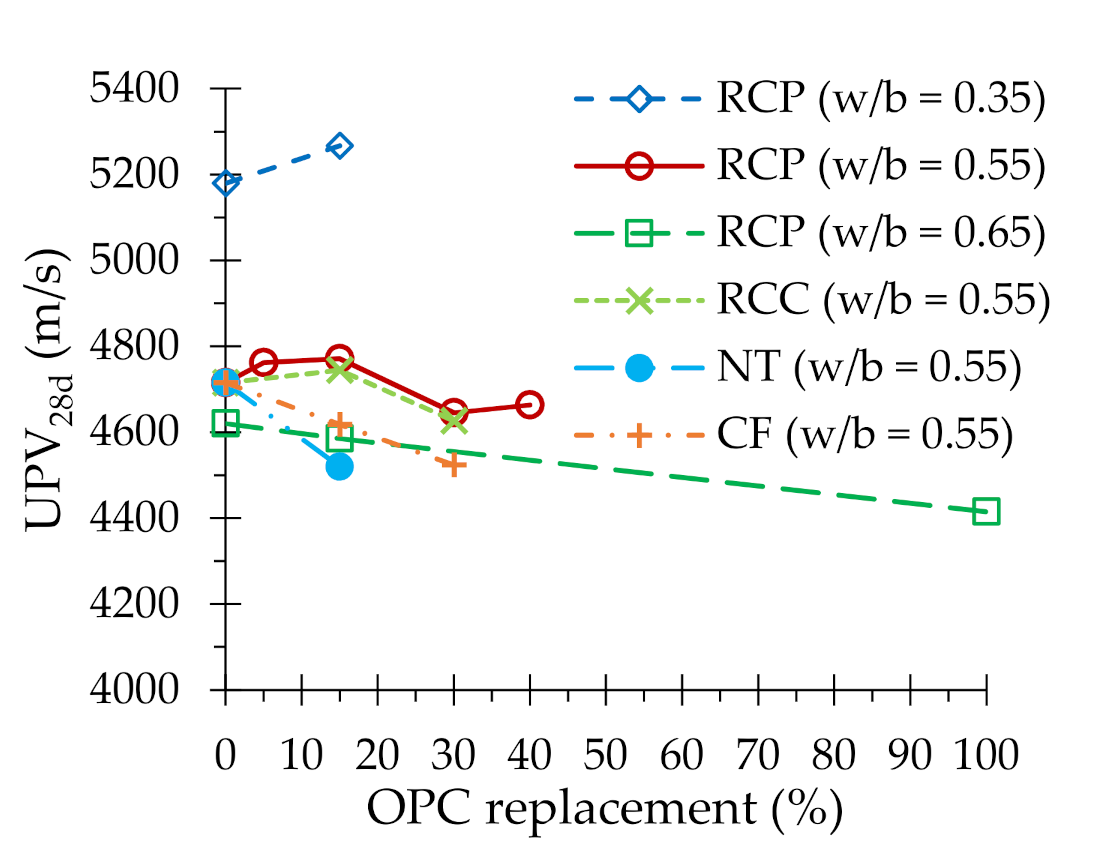
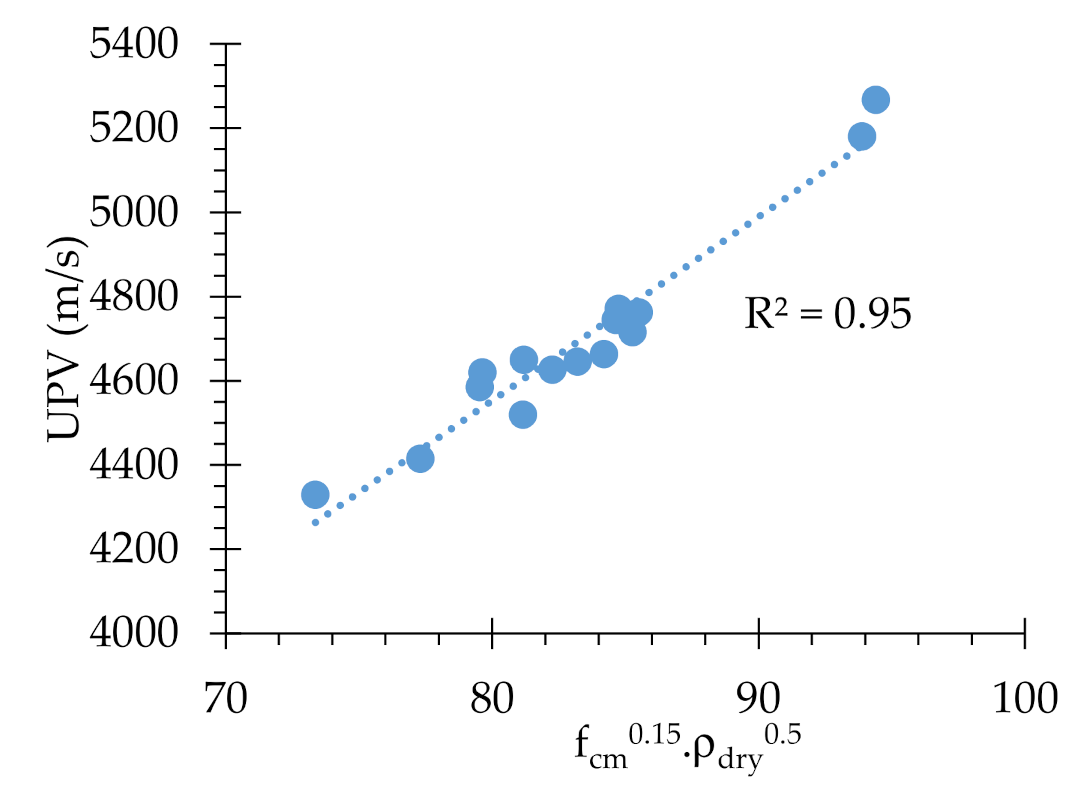

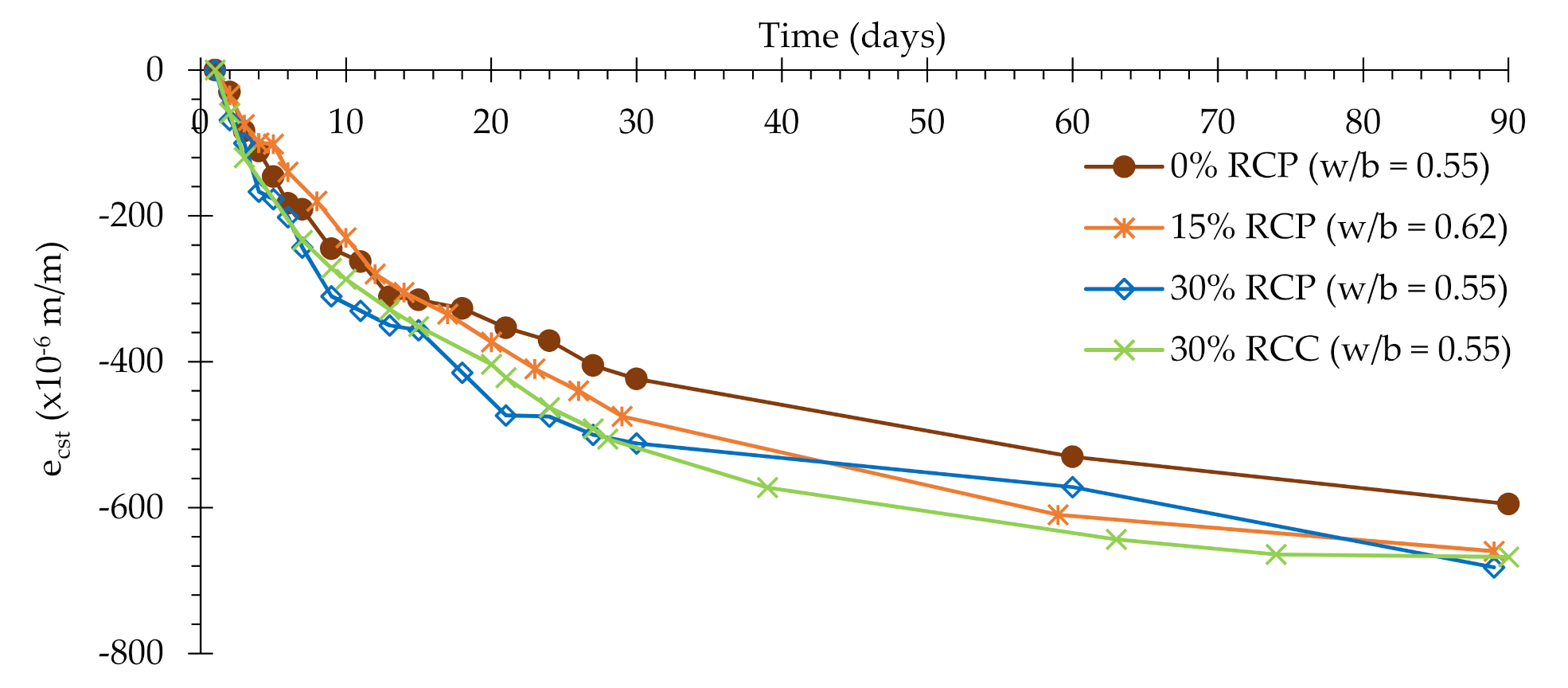
| Parameter | Standard | Sand | Crushed Limestone | |||
|---|---|---|---|---|---|---|
| Fine Sand | Coarse Sand | Fine Gravel | Coarse Gravel 1 | Coarse Gravel 2 | ||
| Oven-dried particle density (kg/m3) | EN 1097-6 [23] | 2598 | 2599 | 2669 | 2683 | 2650 |
| Water absorption at 24 h (%) | EN 1097-6 [23] | 0.15 | 0.26 | 0.39 | 0.31 | 0.46 |
| Loose bulk density (kg/m3) | EN 1097-3 [24] | 1588 | 1606 | 1424 | 1420 | 1462 |
| Granulometric fraction (di/Di) | EN 12,620 [25] | 0/1 | 0/2 | 2/8 | 4/11.2 | 11.2/20 |
| Parameter | Standard | OPC | NT | RCP | RCC | CF | |
|---|---|---|---|---|---|---|---|
| Absolute density (g/cm3) | 3.07 (a) | 2.445 (b) | 3.005 (b) | 2.964 (b) | - | ||
| BET surface area (cm2/g) | 18134 | - | 156853 | 78673 | - | ||
| Loss on ignition (950 °C) (%) | 2.48 | 20.65 | 8.41 | - | 28.71 | ||
| Insoluble residue (%) | 0.89 | 0.8 | <0.52 | - | 18.77 | ||
| SiO2 + Al2O3 + Fe2O3 (%) | EN 196-2 [26] | 19.64 + 5.34 + 3.05 | 14.78 + 3.97 + 2.49 | 19.14 + 5.13 + 3.00 | - | 20.61 + 2.55 + 0.97 | |
| CaO + MgO (%) | EN 196-2 [26] | 62.80 + 1.80 | 50.08 + 1.29 | 60.79 + 1.77 | - | 40.55 + 0.77 | |
| Free CaO (%) | EN 451-1 [27] | 0.70 | - | 13.94 | - | - | |
| Water requirement (w/b) | EN 196-3 [28] | 0.31 | - | 0.74 | 0.50 | - | |
| Setting time (min) | initial | EN 196-3 [28] | 170 | - | 290 | 375 | - |
| final | 280 | - | 385 | 415 | - | ||
| Designation | w/b | Mbinder (kg/m3) | Additions (%) | Vcoarse aggregate (L/m3) | Vfine aggregate (L/m3) | Vwater (L/m3) | SP (% of Mbinder) |
|---|---|---|---|---|---|---|---|
| R35 | 0.35 | 450 | - | 406 | 270 | 157.5 | 0.5 |
| R55 | 0.55 | 360 | - | 400 | 266 | 198 | - |
| R65 | 0.65 | 360 | - | 378 | 252 | 234 | - |
| 5P55 | 0.55 | 360 | 5%RCP | 399 | 266 | 198 | - |
| 15P35 | 0.35 | 450 | 15%RCP | 404 | 269 | 157.5 | 1.0 (a) |
| 15P55 | 0.55 | 360 | 15%RCP | 399 | 266 | 198 | - |
| 15P62 | 0.62 | 360 | 15%RCP | 384 | 256 | 223.2 | - |
| 15P65 | 0.65 | 360 | 15%RCP | 377 | 252 | 234 | - |
| 30P55 | 0.55 | 360 | 30%RCP | 398 | 266 | 198 | 0.4 |
| 40P55 | 0.55 | 360 | 40%RCP | 394 | 263 | 198 | 1.5 (a) |
| 100P65 | 0.65 | 360 | 100%RCP | 373 | 248 | 234 | 3.8 (a) |
| 15C55 | 0.55 | 360 | 15%RCC | 398 | 265 | 198 | - |
| 30C55 | 0.55 | 360 | 30%RCC | 397 | 265 | 198 | 0.2 |
| 15NT55 | 0.55 | 360 | 15%NT | 397 | 264 | 198 | - |
| 15CF55 | 0.55 | 360 | 15%CF | 398 | 265 | 198 | - |
| 30CF55 | 0.55 | 360 | 30%CF | 396 | 264 | 198 | - |
| Designation | w/b | Slump (mm) | Fresh Density | Volume of Voids | Dry Density | Compressive Strength | Ultrasonic Pulse Velocity | Tensile Splitting Strength | Modulus of Elasticity | ||||||||||
|---|---|---|---|---|---|---|---|---|---|---|---|---|---|---|---|---|---|---|---|
| 28d | 3d | 7d | 28d | 90d | 28d | 28d | 28d | ||||||||||||
| ρfresh (kg/m3) | Vvoids (L/m3) | ρdry (kg/m3) | fcm (MPa) | CV (%) | fcm (MPa) | CV (%) | fcm (MPa) | CV (%) | fcm (MPa) | CV (%) | UPV (m/s) | CV (%) | fctm,sp (MPa) | CV (%) | Ecm (GPa) | CV (%) | |||
| R35 | 0.35 | 150 | 2360 | 34 | 2330 | 63.6 | 3 | 72.1 | 3 | 84.4 | 1 | 93.5 | 4 | 5180 | 0 | 5.5 | 12 | - | - |
| R55 | 0.55 | 150 | 2330 | 13 | 2220 | 33.7 | 1 | 42.0 | 3 | 52.2 | 1 | 59.2 | 0 | 4716 | 0 | 3.6 | 5 | 40.0 | 1 |
| R65 | 0.65 | Fluid | 2280 | 8 | 2100 | 27.9 | 1 | 33.4 | 2 | 39.8 | 3 | - | - | 4620 | 0 | 2.7 | 2 | - | - |
| 5P55 | 0.55 | 130 | 2320 | 17 | 2220 | 35.8 | 1 | 44.5 | 1 | 53.2 | 3 | - | - | 4762 | 0 | 4.0 | 7 | - | - |
| 15P35 | 0.35 | 100 | 2340 | 35 | 2310 | 76.3 | 3 | 86.1 | 1 | 90.0 | 4 | - | - | 5268 | 0 | 5.5 | - | - | - |
| 15P55 | 0.55 | 90 | 2290 | 27 | 2190 | 34.7 | 1 | 42.9 | 3 | 52.4 | 1 | 57.9 | 2 | 4771 | 1 | 4.1 | 2 | 38.8 | 3 |
| 15P62 | 0.62 | 140 | 2260 | 26 | 2110 | 31.1 | 2 | 35.8 | 1 | 44.6 | 2 | - | - | 4650 | 1 | 3.5 | 11 | - | - |
| 15P65 | 0.65 | 190 | 2230 | 28 | 2090 | 27.9 | 1 | 33.5 | 1 | 40.1 | 1 | - | - | 4585 | 0 | 3.5 | 1 | - | - |
| 30P55 | 0.55 | 110 | 2280 | 30 | 2170 | 33.7 | 2 | 40.1 | 0 | 47.8 | 2 | 50.7 | 5 | 4646 | 0 | 3.3 | 3 | 36.4 | 2 |
| 40P55 | 0.55 | 190 | 2290 | 19 | 2160 | 37.4 | 1 | 44.4 | 1 | 52.5 | 2 | - | - | 4663 | 0 | 3.6 | 9 | - | - |
| 100P65 | 0.65 | 100 | 2220 | 24 | 2090 | 28.5 | 0 | 30.2 | 1 | 33.2 | 2 | - | - | 4415 | 0 | 2.2 | 6 | - | - |
| 15C55 | 0.55 | 120 | 2290 | 28 | 2190 | 30.0 | 1 | 42.2 | 2 | 52.0 | 1 | - | - | 4745 | 0 | 3.8 | - | - | - |
| 30C55 | 0.55 | 130 | 2270 | 33 | 2160 | 24.2 | 1 | 36.5 | 1 | 45.0 | 0 | - | - | 4626 | 1 | 3.3 | - | - | - |
| 15NT55 | 0.55 | 110 | 2270 | 38 | 2130 | 29.0 | 2 | 35.8 | 3 | 43.1 | 3 | - | - | 4520 | 1 | 3.2 | 11 | - | - |
| 15CF55 | 0.55 | 130 | 2300 | 21 | 2150 | 29.5 | 2 | 35.6 | 3 | 43.1 | 3 | - | - | 4618 | 0 | 2.7 | 10 | - | - |
| 30CF55 | 0.55 | 140 | 2300 | 21 | 2130 | 22.3 | 1 | 26.8 | 3 | 32.8 | 0 | - | - | 4524 | 0 | 2.4 | 14 | - | - |
Publisher’s Note: MDPI stays neutral with regard to jurisdictional claims in published maps and institutional affiliations. |
© 2021 by the authors. Licensee MDPI, Basel, Switzerland. This article is an open access article distributed under the terms and conditions of the Creative Commons Attribution (CC BY) license (http://creativecommons.org/licenses/by/4.0/).
Share and Cite
Real, S.; Bogas, J.A.; Carriço, A.; Hu, S. Mechanical Characterisation and Shrinkage of Thermoactivated Recycled Cement Concrete. Appl. Sci. 2021, 11, 2454. https://doi.org/10.3390/app11062454
Real S, Bogas JA, Carriço A, Hu S. Mechanical Characterisation and Shrinkage of Thermoactivated Recycled Cement Concrete. Applied Sciences. 2021; 11(6):2454. https://doi.org/10.3390/app11062454
Chicago/Turabian StyleReal, Sofia, José Alexandre Bogas, Ana Carriço, and Susana Hu. 2021. "Mechanical Characterisation and Shrinkage of Thermoactivated Recycled Cement Concrete" Applied Sciences 11, no. 6: 2454. https://doi.org/10.3390/app11062454
APA StyleReal, S., Bogas, J. A., Carriço, A., & Hu, S. (2021). Mechanical Characterisation and Shrinkage of Thermoactivated Recycled Cement Concrete. Applied Sciences, 11(6), 2454. https://doi.org/10.3390/app11062454






